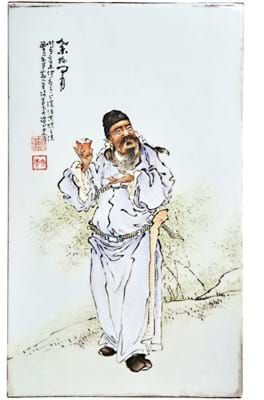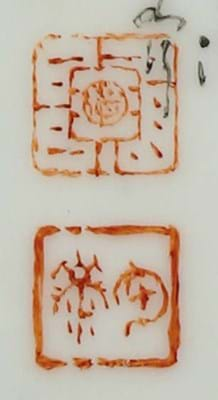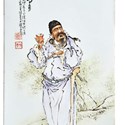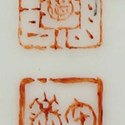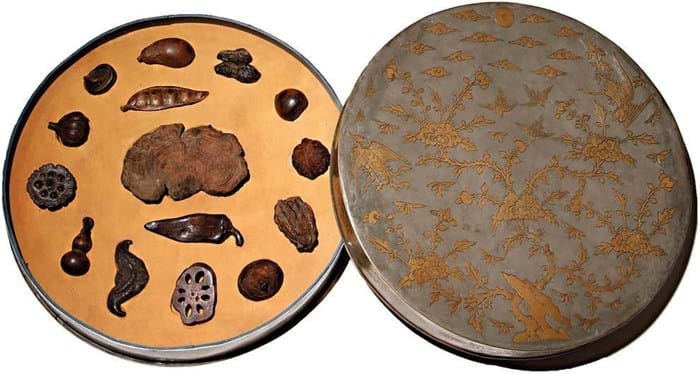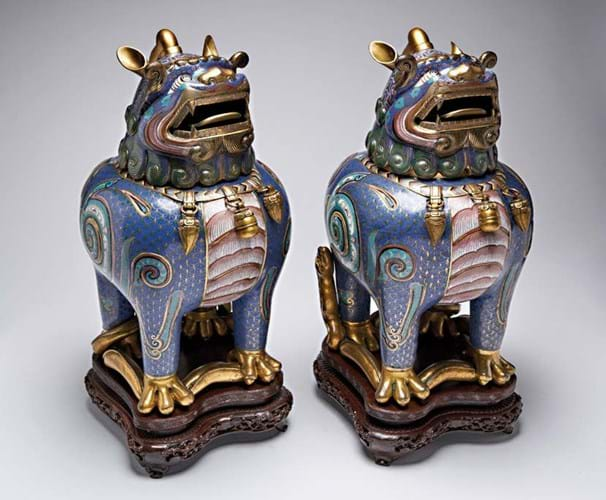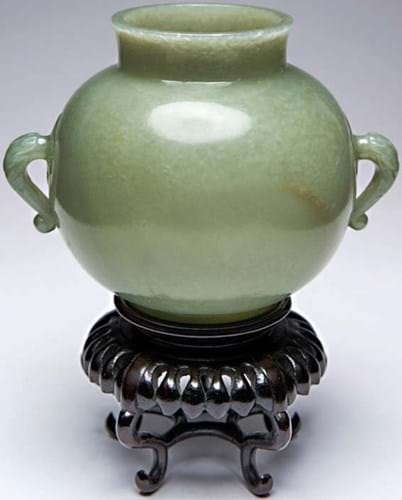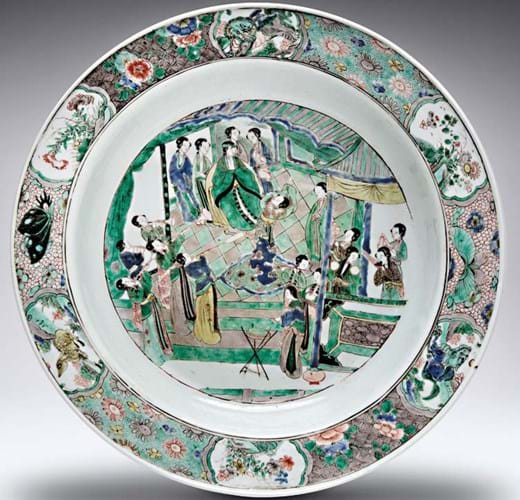While the market is already looking ahead to the November series of Asian art, it would be remiss not to return to the Fine Chinese Paintings and Works of Art sale at Woolley & Wallis (25% buyer’s premium) in Salisbury on July 27.
A sale of 191 lots that generated a hammer total £2.05m, it was followed by separate catalogues of Japanese art and Asian art that added a further £1.05m.
The overall selling rate across 927 lots was 84%, a better aggregate than some of the equivalent London sales held during the April lockdown.
The financial highlight was a set of four porcelain plaques by the celebrated Republic period artist Wang Qi (1884-1937).
One of the seven artists who founded the society now commonly referred to as the ‘Eight Friends of Zhushan’, his forte was scenes of folkloric figures.
These four plaques in hardwood frames, dated to the xinwei year (1931), depict the ‘Drunken Poet’ Li Bai holding a wine cup, the ‘Vanquisher of Ghosts’ Zhong Kui trying to catch a flying bat, the Daoist immortal Li Teiguai gazing at smoke emerging from a gourd, and the fourth, an elderly scholar seated beneath an inscription recounting his encounter with the philosopher Confucius.
They were purchased from a dealer (a Mr Wong) on Cat Street, in Hong Kong, c.1968, by Colonel Timothy Van Rees, who served with the Welch Regiment in Hong Kong from 1966-69 and again from 1971-73 (by which time it had become the Royal Regiment of Wales).
The catalogue referenced a smaller plaque (at 8 x 5in it was roughly half the size) sold at Sotheby’s in 2007. Dated 1933 and depicting the scene of ‘Releasing the Crane from Gushan’, it had sold at £11,000.
This quartet estimated £30,000-50,000 made a more muscular £400,000. It sold to a phone bidder from the Far East: there were buyers in the room but many of the regulars who come over for this sale were not able to attend.
Renowned collection
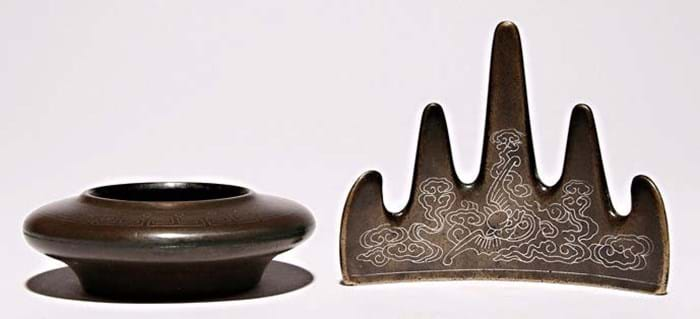
A ‘shi sou’ silver inlaid bronze brush rest and brush washer from the Plesch collection – £22,000 at Woolley & Wallis.
Seven lots offered in the first hour of the sale came by descent from the renowned collection of Prof Peter Hariolf Plesch (1918-2013). A polymer chemist, he was twice in the Guinness Book of Records: once in 1959 as the buyer of the highest price ever paid for any kind of ceramic (a Ruyao narcissus bowl sold at Sotheby’s for £2200) and then in 1970 when that piece was resold for £46,000.
Sold here at £22,000 were an 18th century ‘Shi Sou’ type silver inlaid bronze brush rest formed as a mountain range and an ensuite brushwasher decorated with a geometric band and small circles encircling the rim. The rest had been bought by Plesch in Cat Street, Hong Kong and the washer purchased from Ushida Woodblock Printing Co in Kyoto in October 1967.
Equally admired
An equally admired scholar’s taste item from another vendor was a 14in (35cm) parcel gilt pewter box decorated with a phoenix and other birds among peony that opens to reveal 15 aloeswood carvings formed as lingzhi, fruits, vegetables, seeds and nuts.
The inscription in silk amounts to a poem about the contents dated to the guihai year with a seal mark reading Jiaqing yu bi. Dated to the ‘Qing dynasty or later’, it attracted multiple bids at its £5000-8000 and settled at £76,000.
Sold at £28,000 were a pair of cloisonné incense burners and covers modelled as luduan, a highly auspicious creature with the ability to detect the truth, travel over great distances in a very short time and speak all languages of the world.
As they symbolised the emperor’s wisdom and virtue, luduan incense burners formed an important part of court paraphernalia, placed on either side of the Imperial throne with the smoke emanating from the open jaws.
This 14in (35cm) pair, with snake-like creatures at their feet, had six-character Xuande marks but were 19th century. They came from the collection of Sir Raymond and Lady Smith, and had been acquired in a London auction c.1975.
Pitch and provenance
The sale benefited from its focus on affordably pitched objects with a cast-iron provenance – something that the more rigorous trade and private buyers now demand.
An 18th century celadon jade globular form vase retained both a paper label for Spink & Son and its original invoice detailing its purchase there (as Mughal) on June 27, 1966, for £485. It was carved in a greyish-green stone with some russet inclusions with two loop handles emerging from six-petalled flowerheads and measured 5in (13cm) across. The vase hammered at £20,000 (estimate £1500-2000).
Similarly to ‘old-fashioned’ Western collecting taste were a Kangxi (1662-1722) famille verte ‘ladies’ basin (estimate £3000-5000) and a Transitional period blue and white beaker vase (guide £6000-10,000). Measuring almost 16in (39cm) across, the bowl was painted with a large roundel of a dancing lady and musicians performing at a banquet. With an old photograph of the piece from Marchant & Son, it brought £23,000.
The 19in (43cm) gu form vase c.1640, painted with a figural scene of a fisherman in a river landscape watched by a boy and a lady carrying baskets, took £35,000.
It was one of many pieces W&W has sold this year from the collection of the ceramics dealer Lady Kate Davson, née Kate Foster (1938- 2020).
Proof that the best-quality porcelains from the later dynastic periods can also excel, a 12in (30cm) Xianfeng (1851-61) mark and period yuhuchunping (pear-shaped bottle vase) in a copper red glaze sold at £70,000.
‘Sleeper’ vase
Of course, it is also part of the Chinese market that there will always be buyers prepared to go out on a financial limb in the belief an object is a little better than catalogued.
The apparent ‘sleeper’ in this sale was a miniature 4in (10in) famille rose huluping (gourd shaped vase with slender strap handles).
Decorated to each side with panels of two boys playing in a garden and roundels painted en grisaille with river landscape, it had a four-character Qianlong mark to the base.
Similar pieces of this shape, size and decoration from the 18th century are known in the palace collections.
However, this vase, from a West Yorkshire private collection formed in the 1970s-80s, had been examined by a number of council members of the Oriental Ceramics Society who deemed it a Republican copy.
As a 20th century piece with highly auspicious and good-quality decoration it was guided at £1500-2500, but instead took £190,000.


